ECO500 Assignment: Economics, Demand, and Market Analysis Report
VerifiedAdded on 2022/10/15
|18
|2085
|9
Homework Assignment
AI Summary
This economics assignment, ECO500, delves into fundamental economic principles and their application in a managerial context. The assignment begins with an exploration of the three basic economic questions and the role of managers in resource allocation. It then proceeds to analyze demand and supply conditions, including the calculation of equilibrium price and quantity, and the assessment of price elasticity of demand. The solution further examines income elasticity, demand functions, and graphical representations of demand curves. The analysis extends to the impact of various factors on demand, such as own price, prices of substitutes, and income, along with an evaluation of the model's explanatory power using R-squared and t-values. The assignment also covers economies of scale, minimum efficient scale, and the kinked demand curve model in oligopoly markets, offering insights into firm behavior and pricing strategies. The provided solution offers a comprehensive guide to the key concepts and analytical tools used in managerial economics, making it a valuable resource for students studying this subject.
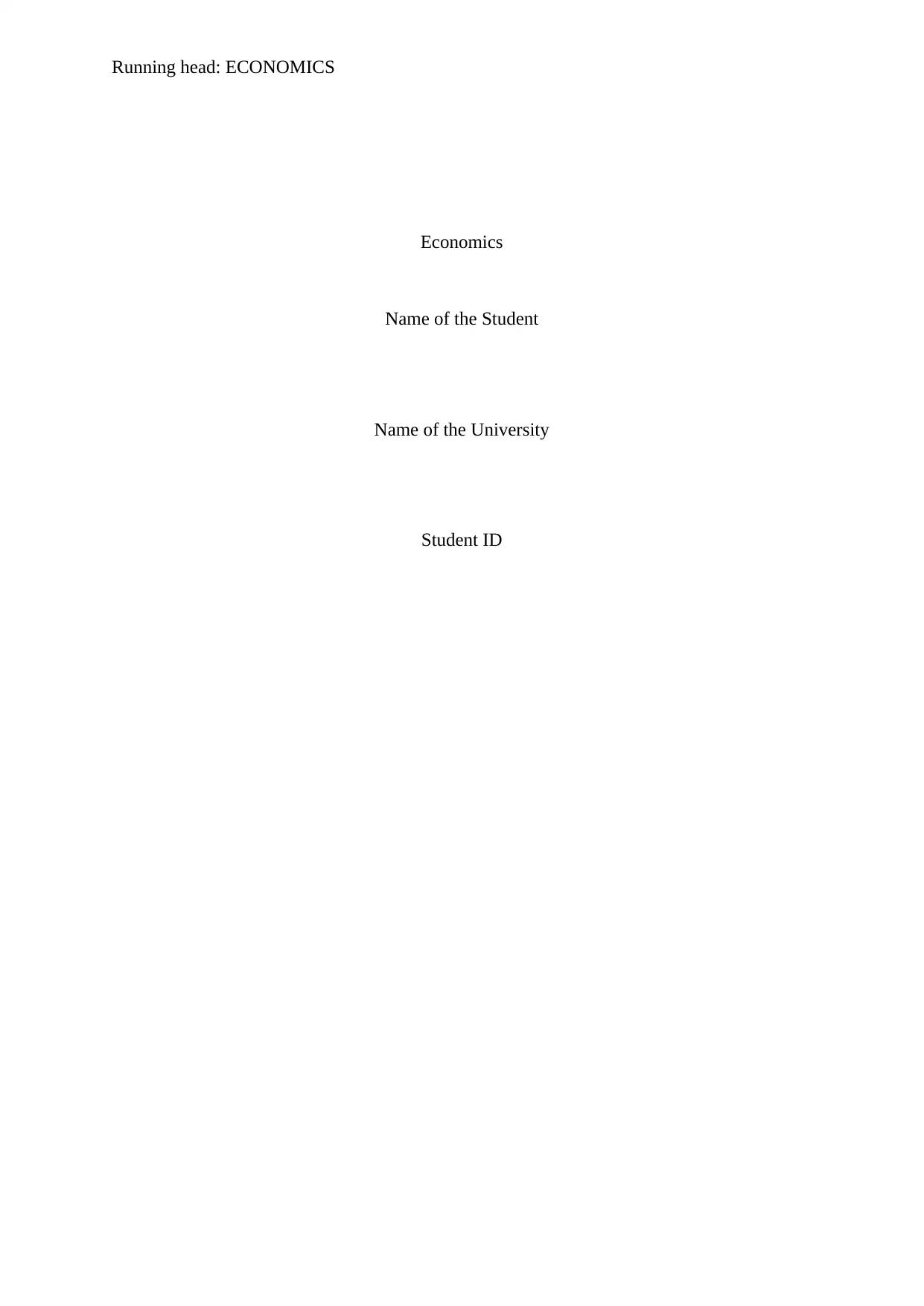
Running head: ECONOMICS
Economics
Name of the Student
Name of the University
Student ID
Economics
Name of the Student
Name of the University
Student ID
Paraphrase This Document
Need a fresh take? Get an instant paraphrase of this document with our AI Paraphraser
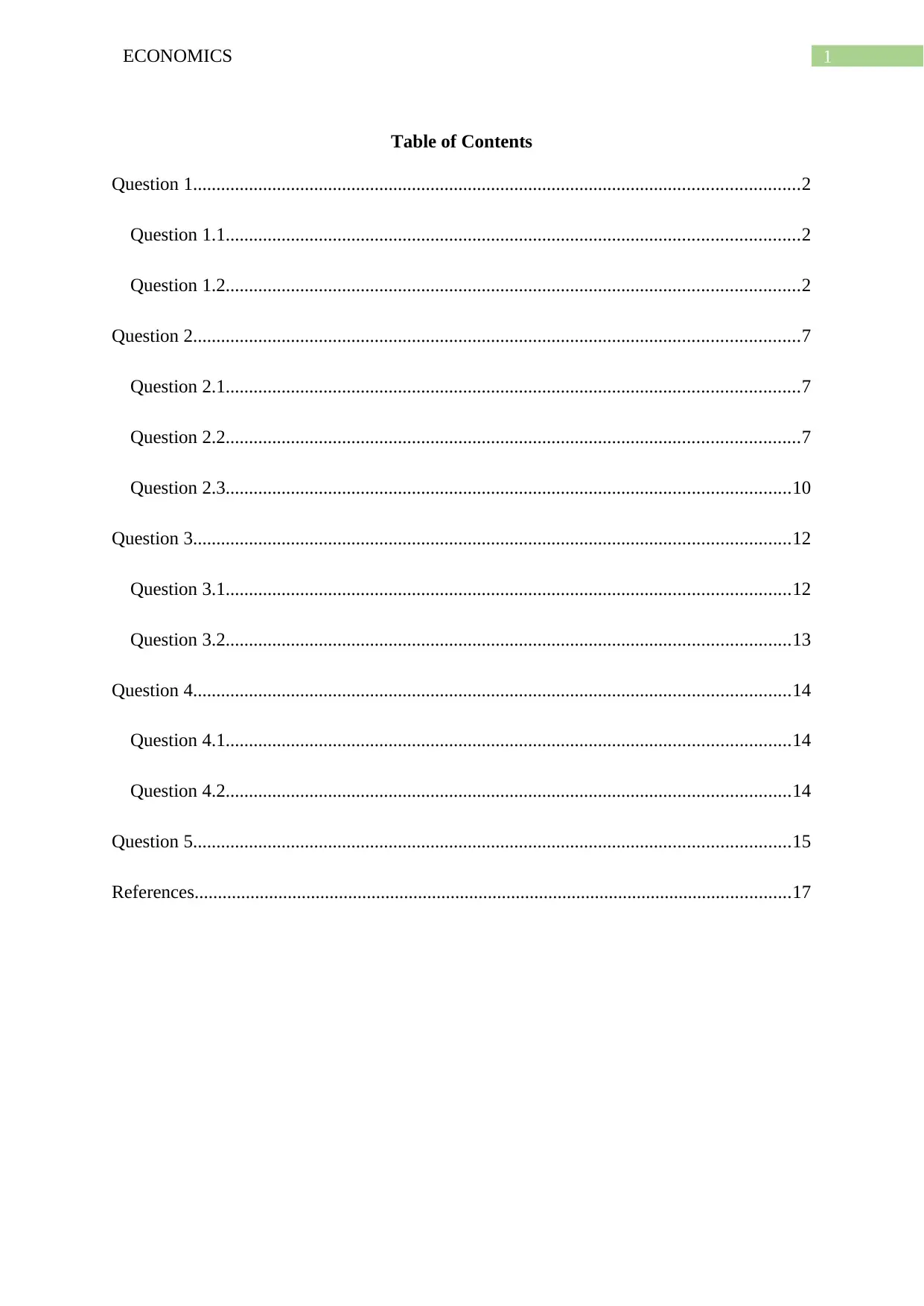
1ECONOMICS
Table of Contents
Question 1..................................................................................................................................2
Question 1.1...........................................................................................................................2
Question 1.2...........................................................................................................................2
Question 2..................................................................................................................................7
Question 2.1...........................................................................................................................7
Question 2.2...........................................................................................................................7
Question 2.3.........................................................................................................................10
Question 3................................................................................................................................12
Question 3.1.........................................................................................................................12
Question 3.2.........................................................................................................................13
Question 4................................................................................................................................14
Question 4.1.........................................................................................................................14
Question 4.2.........................................................................................................................14
Question 5................................................................................................................................15
References................................................................................................................................17
Table of Contents
Question 1..................................................................................................................................2
Question 1.1...........................................................................................................................2
Question 1.2...........................................................................................................................2
Question 2..................................................................................................................................7
Question 2.1...........................................................................................................................7
Question 2.2...........................................................................................................................7
Question 2.3.........................................................................................................................10
Question 3................................................................................................................................12
Question 3.1.........................................................................................................................12
Question 3.2.........................................................................................................................13
Question 4................................................................................................................................14
Question 4.1.........................................................................................................................14
Question 4.2.........................................................................................................................14
Question 5................................................................................................................................15
References................................................................................................................................17
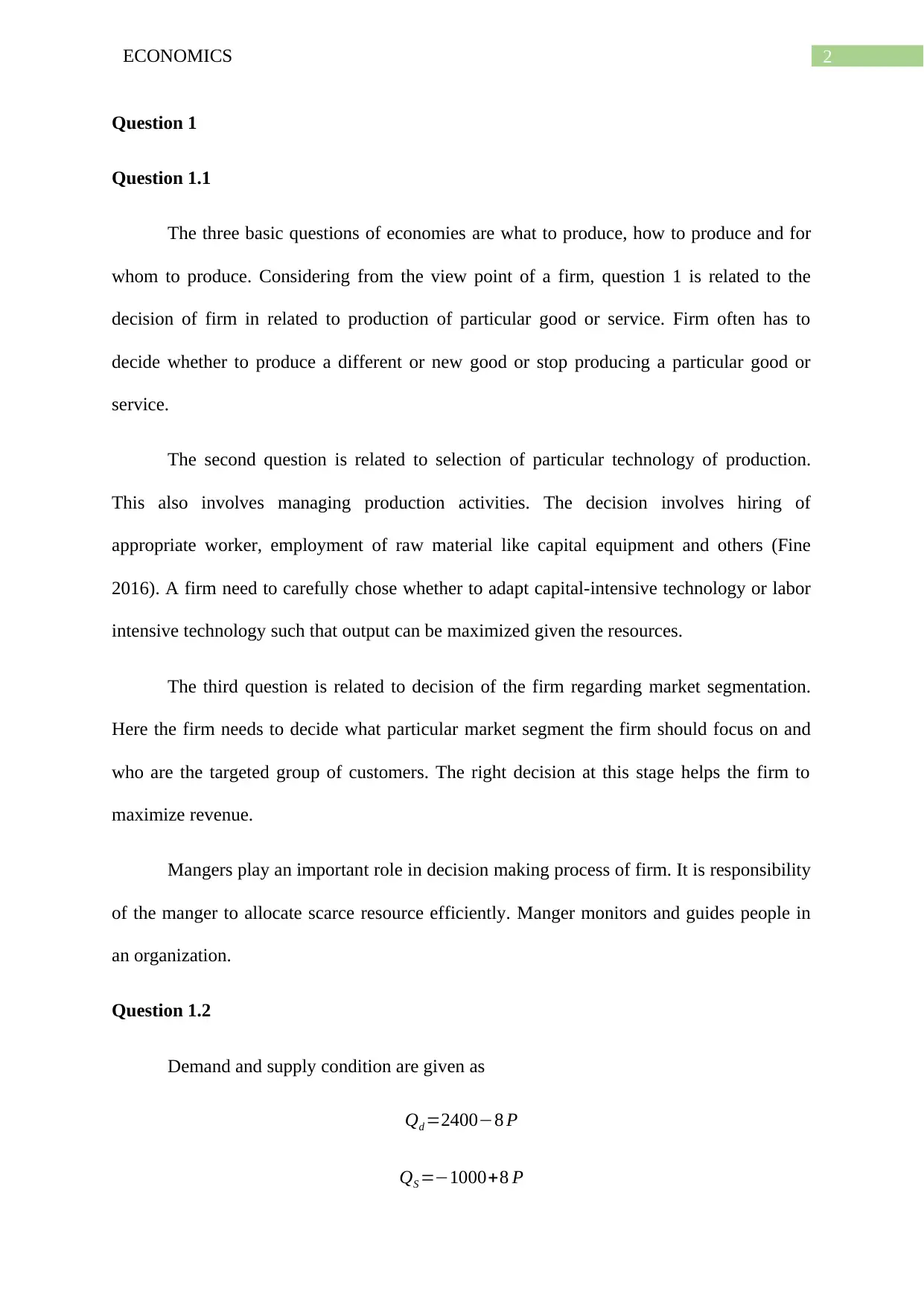
2ECONOMICS
Question 1
Question 1.1
The three basic questions of economies are what to produce, how to produce and for
whom to produce. Considering from the view point of a firm, question 1 is related to the
decision of firm in related to production of particular good or service. Firm often has to
decide whether to produce a different or new good or stop producing a particular good or
service.
The second question is related to selection of particular technology of production.
This also involves managing production activities. The decision involves hiring of
appropriate worker, employment of raw material like capital equipment and others (Fine
2016). A firm need to carefully chose whether to adapt capital-intensive technology or labor
intensive technology such that output can be maximized given the resources.
The third question is related to decision of the firm regarding market segmentation.
Here the firm needs to decide what particular market segment the firm should focus on and
who are the targeted group of customers. The right decision at this stage helps the firm to
maximize revenue.
Mangers play an important role in decision making process of firm. It is responsibility
of the manger to allocate scarce resource efficiently. Manger monitors and guides people in
an organization.
Question 1.2
Demand and supply condition are given as
Qd =2400−8 P
QS =−1000+8 P
Question 1
Question 1.1
The three basic questions of economies are what to produce, how to produce and for
whom to produce. Considering from the view point of a firm, question 1 is related to the
decision of firm in related to production of particular good or service. Firm often has to
decide whether to produce a different or new good or stop producing a particular good or
service.
The second question is related to selection of particular technology of production.
This also involves managing production activities. The decision involves hiring of
appropriate worker, employment of raw material like capital equipment and others (Fine
2016). A firm need to carefully chose whether to adapt capital-intensive technology or labor
intensive technology such that output can be maximized given the resources.
The third question is related to decision of the firm regarding market segmentation.
Here the firm needs to decide what particular market segment the firm should focus on and
who are the targeted group of customers. The right decision at this stage helps the firm to
maximize revenue.
Mangers play an important role in decision making process of firm. It is responsibility
of the manger to allocate scarce resource efficiently. Manger monitors and guides people in
an organization.
Question 1.2
Demand and supply condition are given as
Qd =2400−8 P
QS =−1000+8 P
⊘ This is a preview!⊘
Do you want full access?
Subscribe today to unlock all pages.

Trusted by 1+ million students worldwide
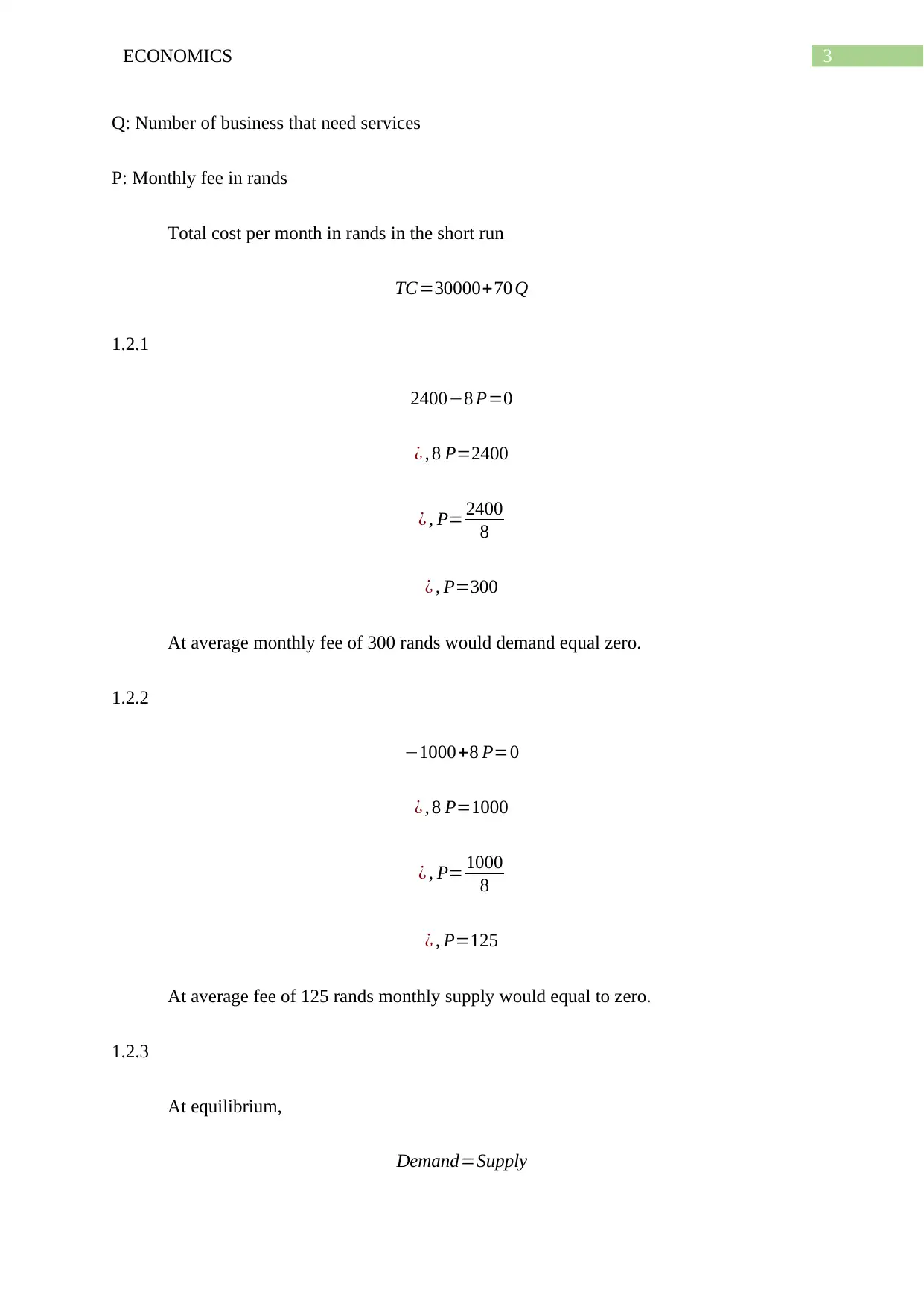
3ECONOMICS
Q: Number of business that need services
P: Monthly fee in rands
Total cost per month in rands in the short run
TC=30000+70 Q
1.2.1
2400−8 P=0
¿ , 8 P=2400
¿ , P= 2400
8
¿ , P=300
At average monthly fee of 300 rands would demand equal zero.
1.2.2
−1000+8 P=0
¿ , 8 P=1000
¿ , P= 1000
8
¿ , P=125
At average fee of 125 rands monthly supply would equal to zero.
1.2.3
At equilibrium,
Demand=Supply
Q: Number of business that need services
P: Monthly fee in rands
Total cost per month in rands in the short run
TC=30000+70 Q
1.2.1
2400−8 P=0
¿ , 8 P=2400
¿ , P= 2400
8
¿ , P=300
At average monthly fee of 300 rands would demand equal zero.
1.2.2
−1000+8 P=0
¿ , 8 P=1000
¿ , P= 1000
8
¿ , P=125
At average fee of 125 rands monthly supply would equal to zero.
1.2.3
At equilibrium,
Demand=Supply
Paraphrase This Document
Need a fresh take? Get an instant paraphrase of this document with our AI Paraphraser
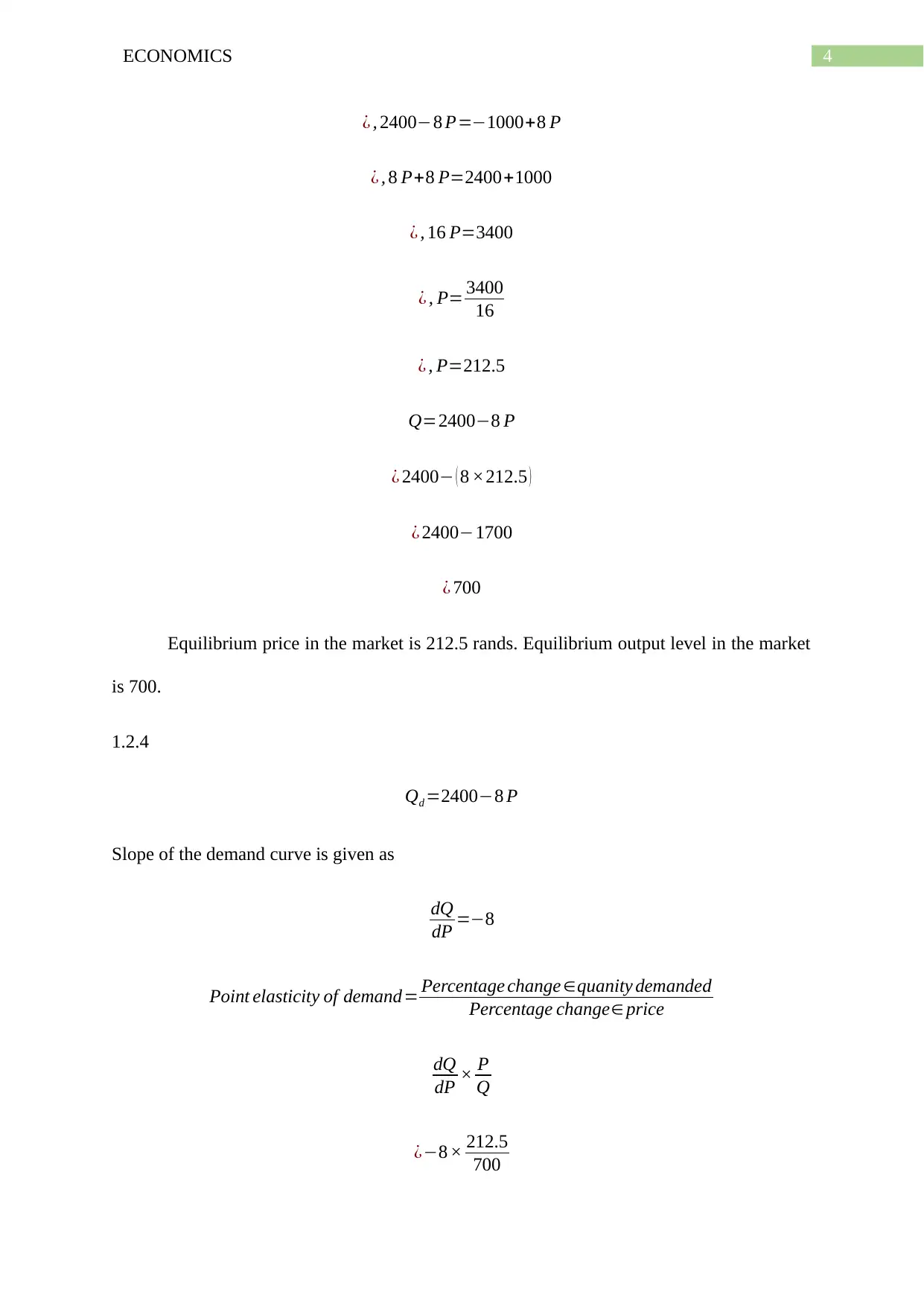
4ECONOMICS
¿ , 2400−8 P=−1000+8 P
¿ , 8 P+8 P=2400+1000
¿ , 16 P=3400
¿ , P= 3400
16
¿ , P=212.5
Q=2400−8 P
¿ 2400− ( 8 ×212.5 )
¿ 2400−1700
¿ 700
Equilibrium price in the market is 212.5 rands. Equilibrium output level in the market
is 700.
1.2.4
Qd =2400−8 P
Slope of the demand curve is given as
dQ
dP =−8
Point elasticity of demand= Percentage change ∈quanity demanded
Percentage change∈ price
dQ
dP × P
Q
¿−8 × 212.5
700
¿ , 2400−8 P=−1000+8 P
¿ , 8 P+8 P=2400+1000
¿ , 16 P=3400
¿ , P= 3400
16
¿ , P=212.5
Q=2400−8 P
¿ 2400− ( 8 ×212.5 )
¿ 2400−1700
¿ 700
Equilibrium price in the market is 212.5 rands. Equilibrium output level in the market
is 700.
1.2.4
Qd =2400−8 P
Slope of the demand curve is given as
dQ
dP =−8
Point elasticity of demand= Percentage change ∈quanity demanded
Percentage change∈ price
dQ
dP × P
Q
¿−8 × 212.5
700
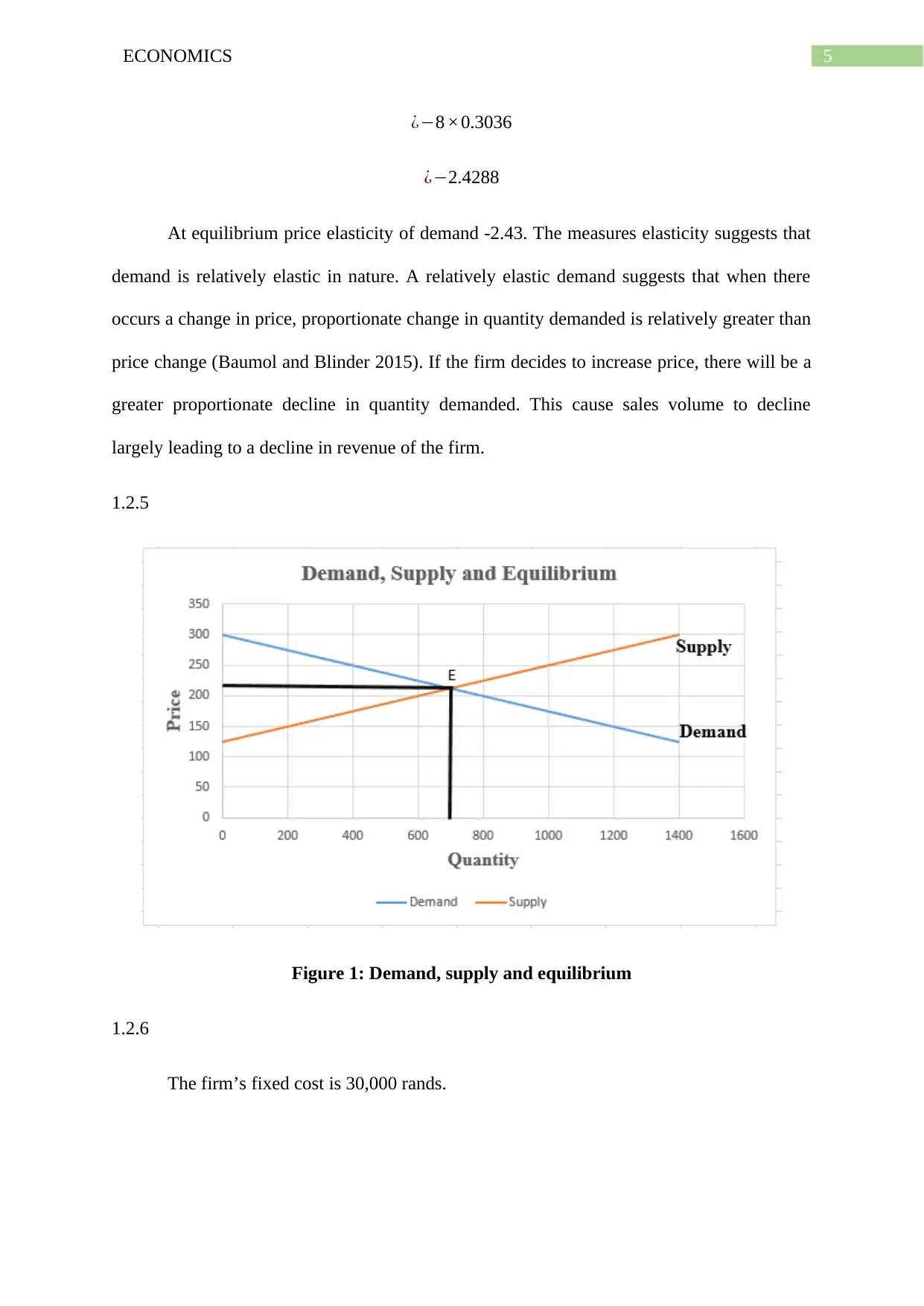
5ECONOMICS
¿−8 ×0.3036
¿−2.4288
At equilibrium price elasticity of demand -2.43. The measures elasticity suggests that
demand is relatively elastic in nature. A relatively elastic demand suggests that when there
occurs a change in price, proportionate change in quantity demanded is relatively greater than
price change (Baumol and Blinder 2015). If the firm decides to increase price, there will be a
greater proportionate decline in quantity demanded. This cause sales volume to decline
largely leading to a decline in revenue of the firm.
1.2.5
Figure 1: Demand, supply and equilibrium
1.2.6
The firm’s fixed cost is 30,000 rands.
¿−8 ×0.3036
¿−2.4288
At equilibrium price elasticity of demand -2.43. The measures elasticity suggests that
demand is relatively elastic in nature. A relatively elastic demand suggests that when there
occurs a change in price, proportionate change in quantity demanded is relatively greater than
price change (Baumol and Blinder 2015). If the firm decides to increase price, there will be a
greater proportionate decline in quantity demanded. This cause sales volume to decline
largely leading to a decline in revenue of the firm.
1.2.5
Figure 1: Demand, supply and equilibrium
1.2.6
The firm’s fixed cost is 30,000 rands.
⊘ This is a preview!⊘
Do you want full access?
Subscribe today to unlock all pages.

Trusted by 1+ million students worldwide
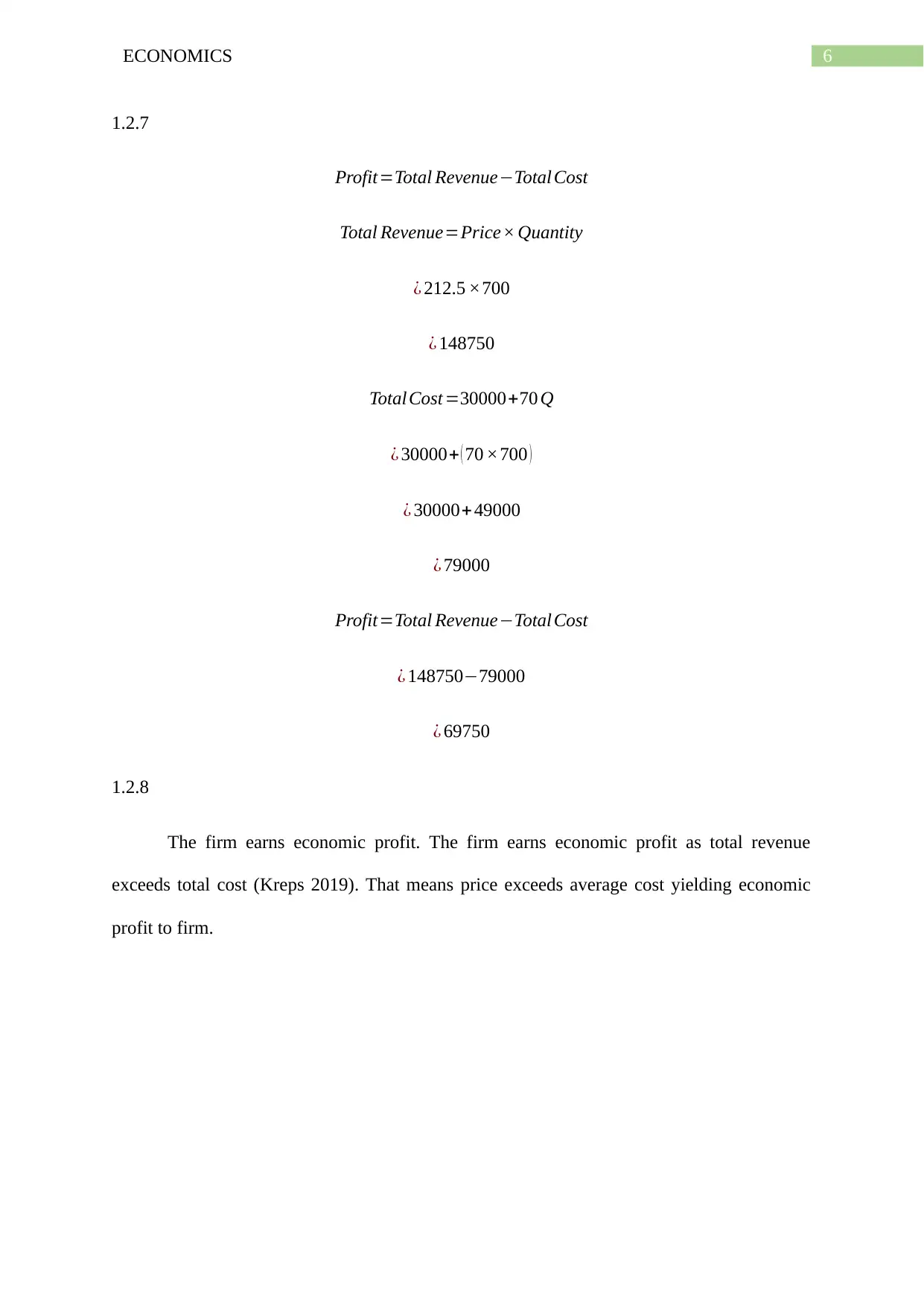
6ECONOMICS
1.2.7
Profit=Total Revenue−Total Cost
Total Revenue=Price× Quantity
¿ 212.5 ×700
¿ 148750
Total Cost =30000+70 Q
¿ 30000+ ( 70 ×700 )
¿ 30000+ 49000
¿ 79000
Profit=Total Revenue−Total Cost
¿ 148750−79000
¿ 69750
1.2.8
The firm earns economic profit. The firm earns economic profit as total revenue
exceeds total cost (Kreps 2019). That means price exceeds average cost yielding economic
profit to firm.
1.2.7
Profit=Total Revenue−Total Cost
Total Revenue=Price× Quantity
¿ 212.5 ×700
¿ 148750
Total Cost =30000+70 Q
¿ 30000+ ( 70 ×700 )
¿ 30000+ 49000
¿ 79000
Profit=Total Revenue−Total Cost
¿ 148750−79000
¿ 69750
1.2.8
The firm earns economic profit. The firm earns economic profit as total revenue
exceeds total cost (Kreps 2019). That means price exceeds average cost yielding economic
profit to firm.
Paraphrase This Document
Need a fresh take? Get an instant paraphrase of this document with our AI Paraphraser
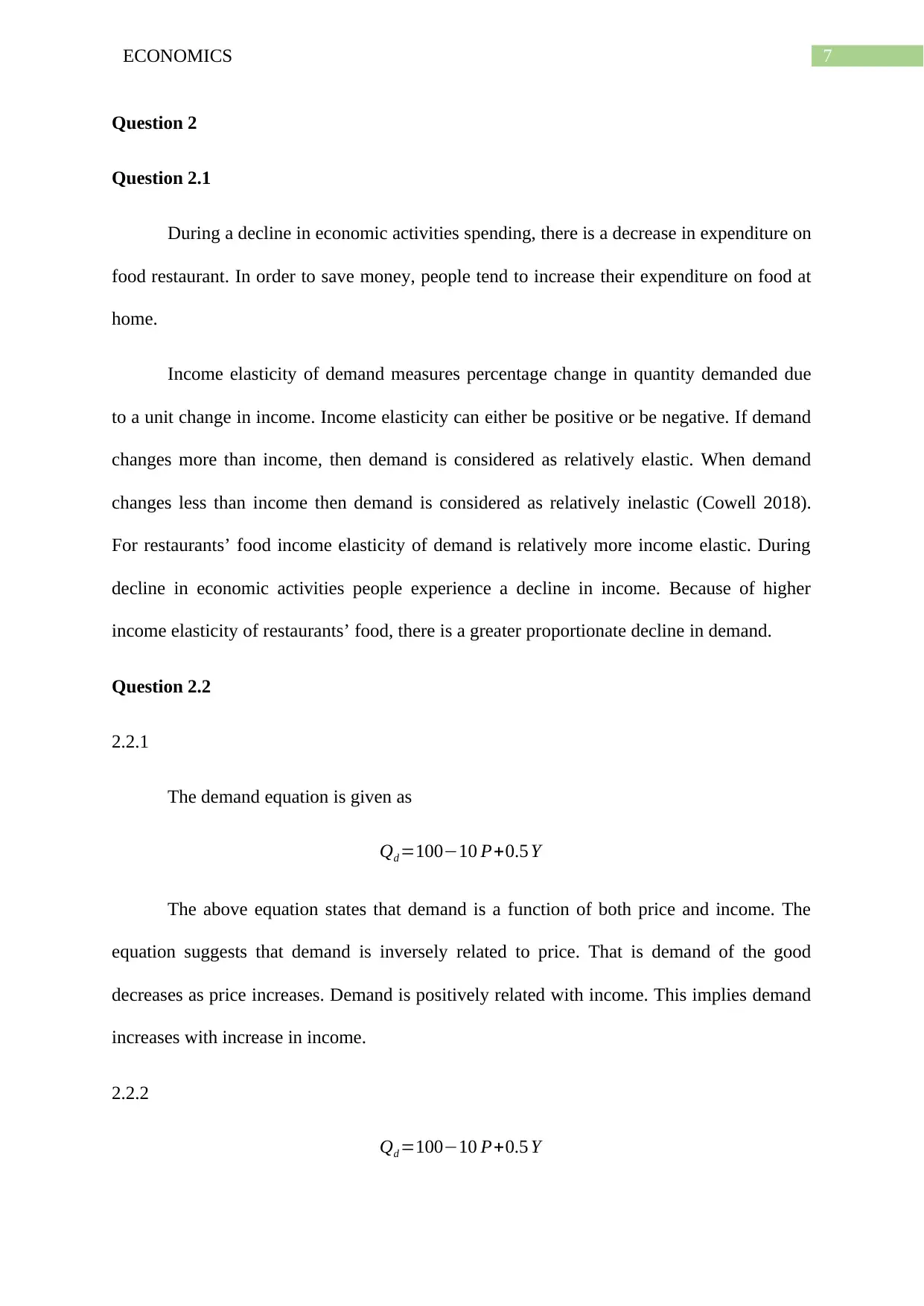
7ECONOMICS
Question 2
Question 2.1
During a decline in economic activities spending, there is a decrease in expenditure on
food restaurant. In order to save money, people tend to increase their expenditure on food at
home.
Income elasticity of demand measures percentage change in quantity demanded due
to a unit change in income. Income elasticity can either be positive or be negative. If demand
changes more than income, then demand is considered as relatively elastic. When demand
changes less than income then demand is considered as relatively inelastic (Cowell 2018).
For restaurants’ food income elasticity of demand is relatively more income elastic. During
decline in economic activities people experience a decline in income. Because of higher
income elasticity of restaurants’ food, there is a greater proportionate decline in demand.
Question 2.2
2.2.1
The demand equation is given as
Qd =100−10 P+0.5 Y
The above equation states that demand is a function of both price and income. The
equation suggests that demand is inversely related to price. That is demand of the good
decreases as price increases. Demand is positively related with income. This implies demand
increases with increase in income.
2.2.2
Qd =100−10 P+0.5 Y
Question 2
Question 2.1
During a decline in economic activities spending, there is a decrease in expenditure on
food restaurant. In order to save money, people tend to increase their expenditure on food at
home.
Income elasticity of demand measures percentage change in quantity demanded due
to a unit change in income. Income elasticity can either be positive or be negative. If demand
changes more than income, then demand is considered as relatively elastic. When demand
changes less than income then demand is considered as relatively inelastic (Cowell 2018).
For restaurants’ food income elasticity of demand is relatively more income elastic. During
decline in economic activities people experience a decline in income. Because of higher
income elasticity of restaurants’ food, there is a greater proportionate decline in demand.
Question 2.2
2.2.1
The demand equation is given as
Qd =100−10 P+0.5 Y
The above equation states that demand is a function of both price and income. The
equation suggests that demand is inversely related to price. That is demand of the good
decreases as price increases. Demand is positively related with income. This implies demand
increases with increase in income.
2.2.2
Qd =100−10 P+0.5 Y
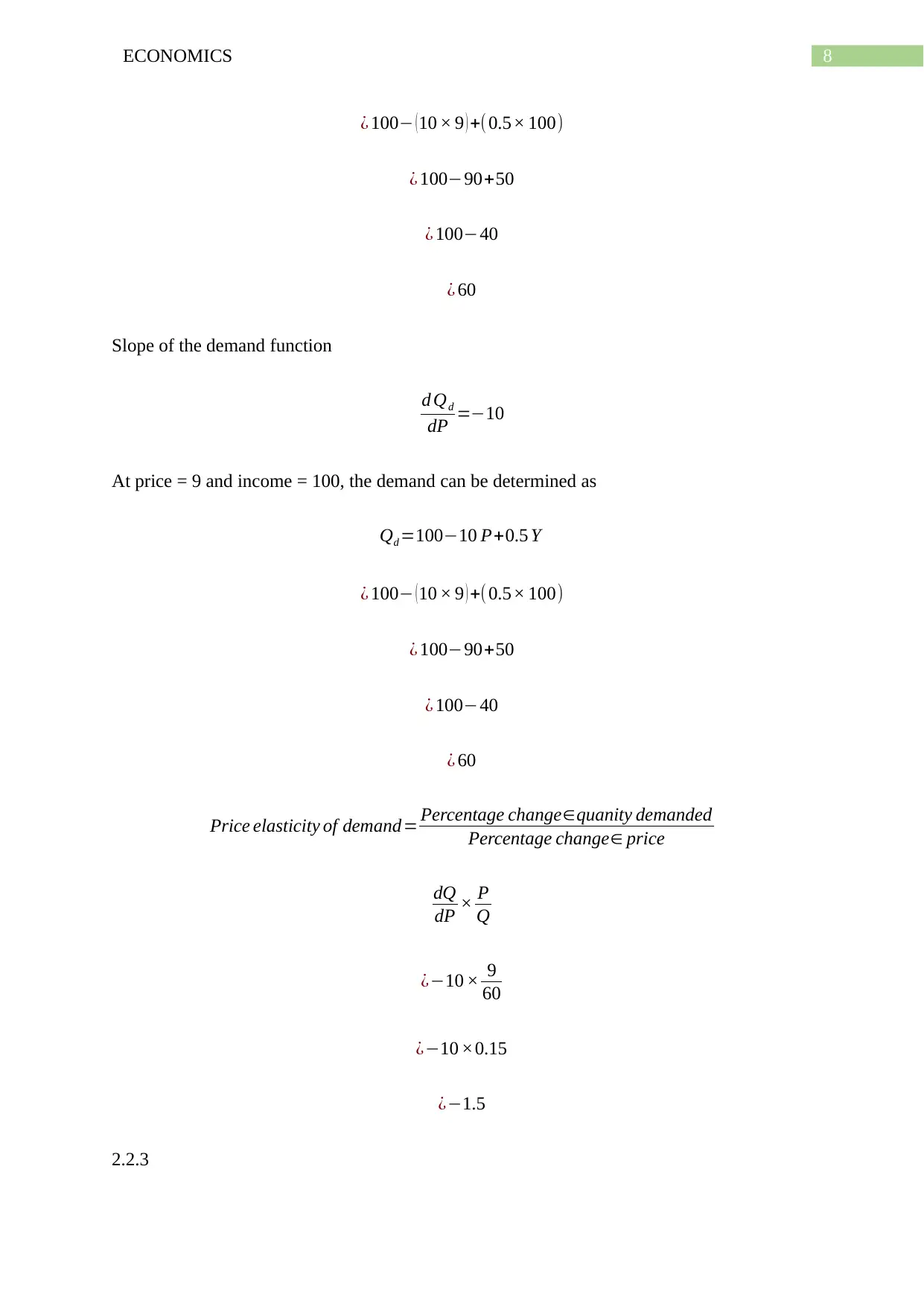
8ECONOMICS
¿ 100− ( 10 × 9 ) +(0.5× 100)
¿ 100−90+50
¿ 100−40
¿ 60
Slope of the demand function
d Qd
dP =−10
At price = 9 and income = 100, the demand can be determined as
Qd =100−10 P+0.5 Y
¿ 100− ( 10 × 9 ) +(0.5× 100)
¿ 100−90+50
¿ 100−40
¿ 60
Price elasticity of demand= Percentage change∈quanity demanded
Percentage change∈ price
dQ
dP × P
Q
¿−10 × 9
60
¿−10 ×0.15
¿−1.5
2.2.3
¿ 100− ( 10 × 9 ) +(0.5× 100)
¿ 100−90+50
¿ 100−40
¿ 60
Slope of the demand function
d Qd
dP =−10
At price = 9 and income = 100, the demand can be determined as
Qd =100−10 P+0.5 Y
¿ 100− ( 10 × 9 ) +(0.5× 100)
¿ 100−90+50
¿ 100−40
¿ 60
Price elasticity of demand= Percentage change∈quanity demanded
Percentage change∈ price
dQ
dP × P
Q
¿−10 × 9
60
¿−10 ×0.15
¿−1.5
2.2.3
⊘ This is a preview!⊘
Do you want full access?
Subscribe today to unlock all pages.

Trusted by 1+ million students worldwide
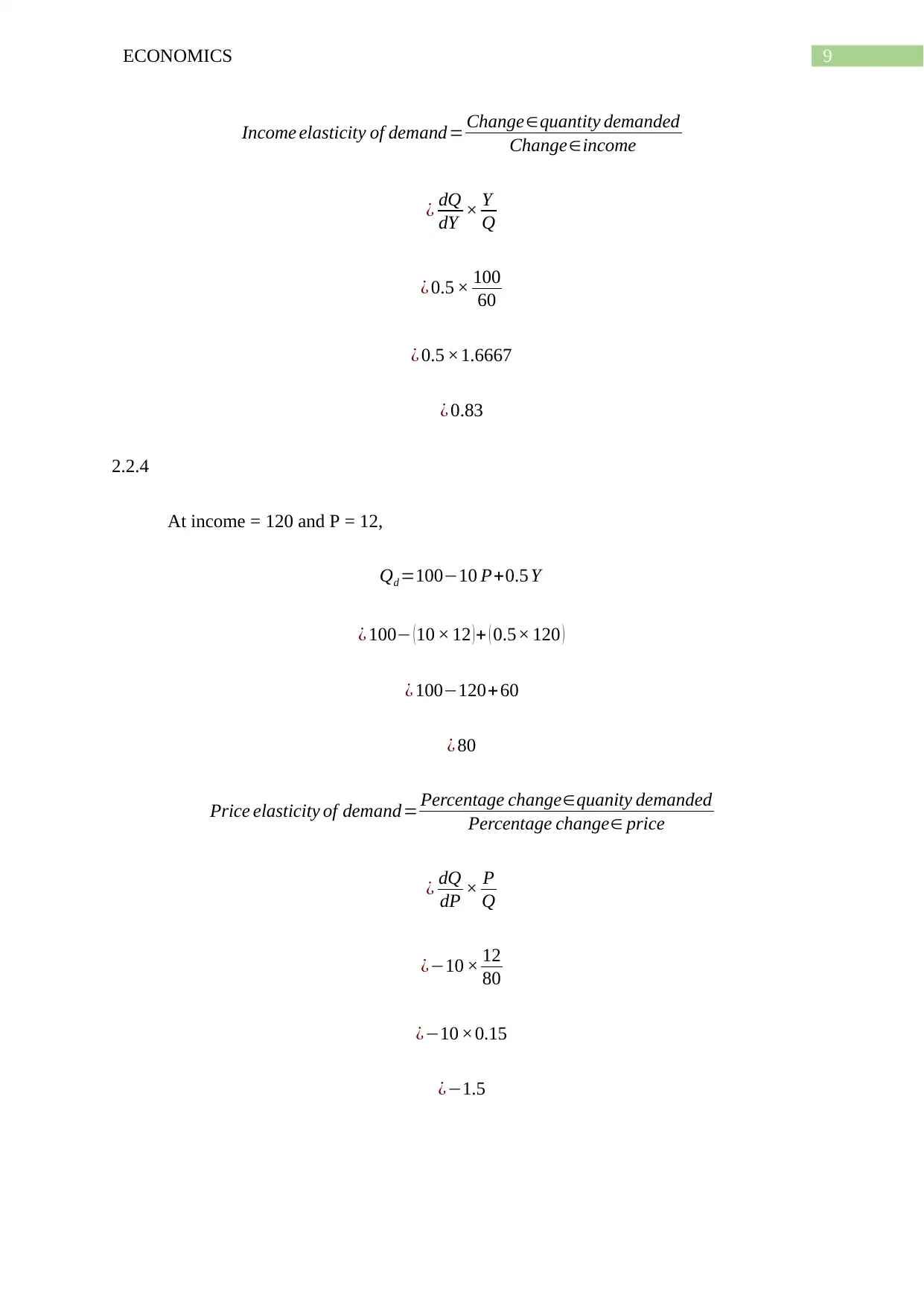
9ECONOMICS
Income elasticity of demand= Change∈quantity demanded
Change∈income
¿ dQ
dY × Y
Q
¿ 0.5 × 100
60
¿ 0.5 ×1.6667
¿ 0.83
2.2.4
At income = 120 and P = 12,
Qd =100−10 P+0.5 Y
¿ 100− (10 × 12 )+ ( 0.5× 120 )
¿ 100−120+60
¿ 80
Price elasticity of demand= Percentage change∈quanity demanded
Percentage change∈ price
¿ dQ
dP × P
Q
¿−10 × 12
80
¿−10 ×0.15
¿−1.5
Income elasticity of demand= Change∈quantity demanded
Change∈income
¿ dQ
dY × Y
Q
¿ 0.5 × 100
60
¿ 0.5 ×1.6667
¿ 0.83
2.2.4
At income = 120 and P = 12,
Qd =100−10 P+0.5 Y
¿ 100− (10 × 12 )+ ( 0.5× 120 )
¿ 100−120+60
¿ 80
Price elasticity of demand= Percentage change∈quanity demanded
Percentage change∈ price
¿ dQ
dP × P
Q
¿−10 × 12
80
¿−10 ×0.15
¿−1.5
Paraphrase This Document
Need a fresh take? Get an instant paraphrase of this document with our AI Paraphraser
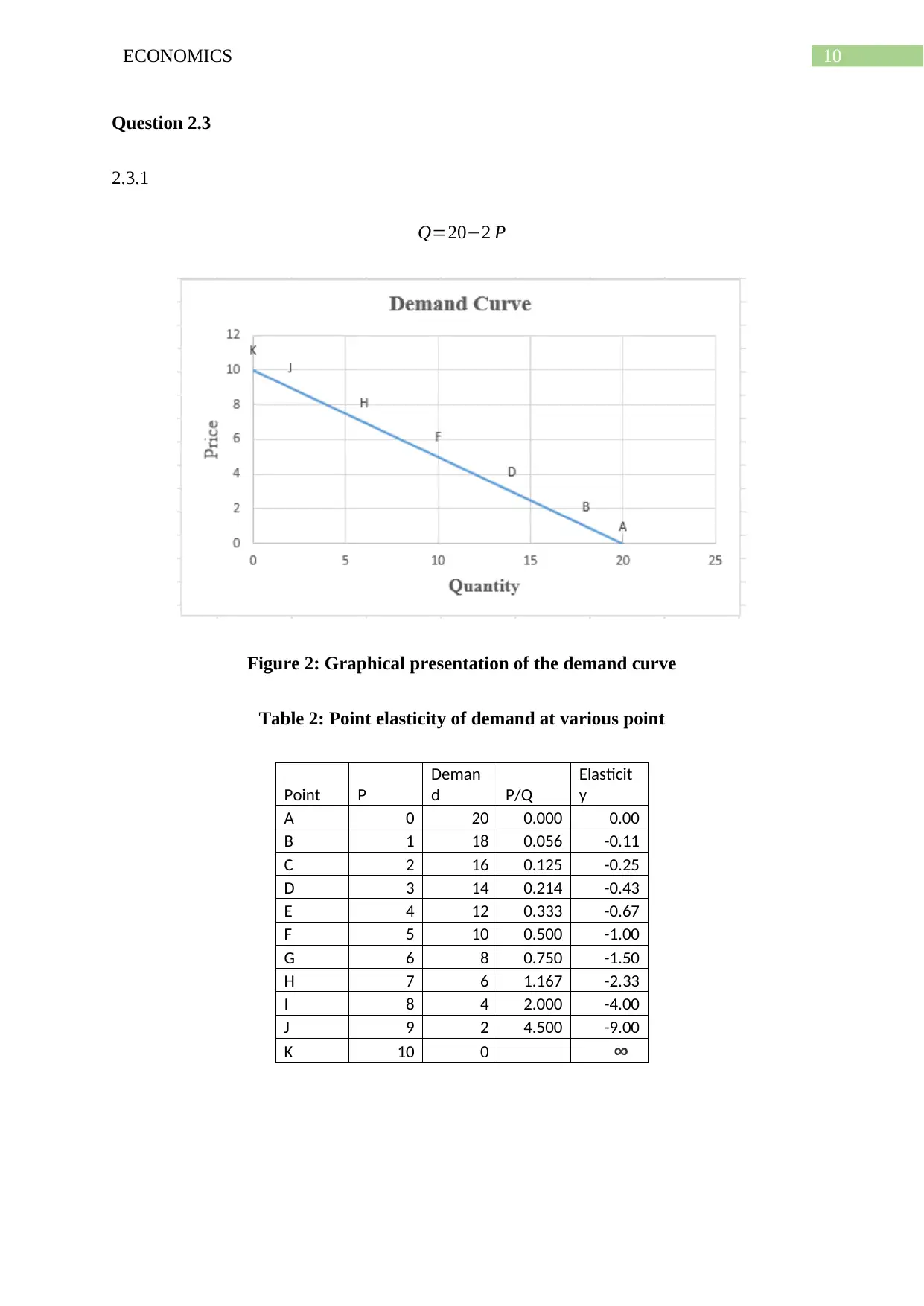
10ECONOMICS
Question 2.3
2.3.1
Q=20−2 P
Figure 2: Graphical presentation of the demand curve
Table 2: Point elasticity of demand at various point
Point P
Deman
d P/Q
Elasticit
y
A 0 20 0.000 0.00
B 1 18 0.056 -0.11
C 2 16 0.125 -0.25
D 3 14 0.214 -0.43
E 4 12 0.333 -0.67
F 5 10 0.500 -1.00
G 6 8 0.750 -1.50
H 7 6 1.167 -2.33
I 8 4 2.000 -4.00
J 9 2 4.500 -9.00
K 10 0 ∞
Question 2.3
2.3.1
Q=20−2 P
Figure 2: Graphical presentation of the demand curve
Table 2: Point elasticity of demand at various point
Point P
Deman
d P/Q
Elasticit
y
A 0 20 0.000 0.00
B 1 18 0.056 -0.11
C 2 16 0.125 -0.25
D 3 14 0.214 -0.43
E 4 12 0.333 -0.67
F 5 10 0.500 -1.00
G 6 8 0.750 -1.50
H 7 6 1.167 -2.33
I 8 4 2.000 -4.00
J 9 2 4.500 -9.00
K 10 0 ∞
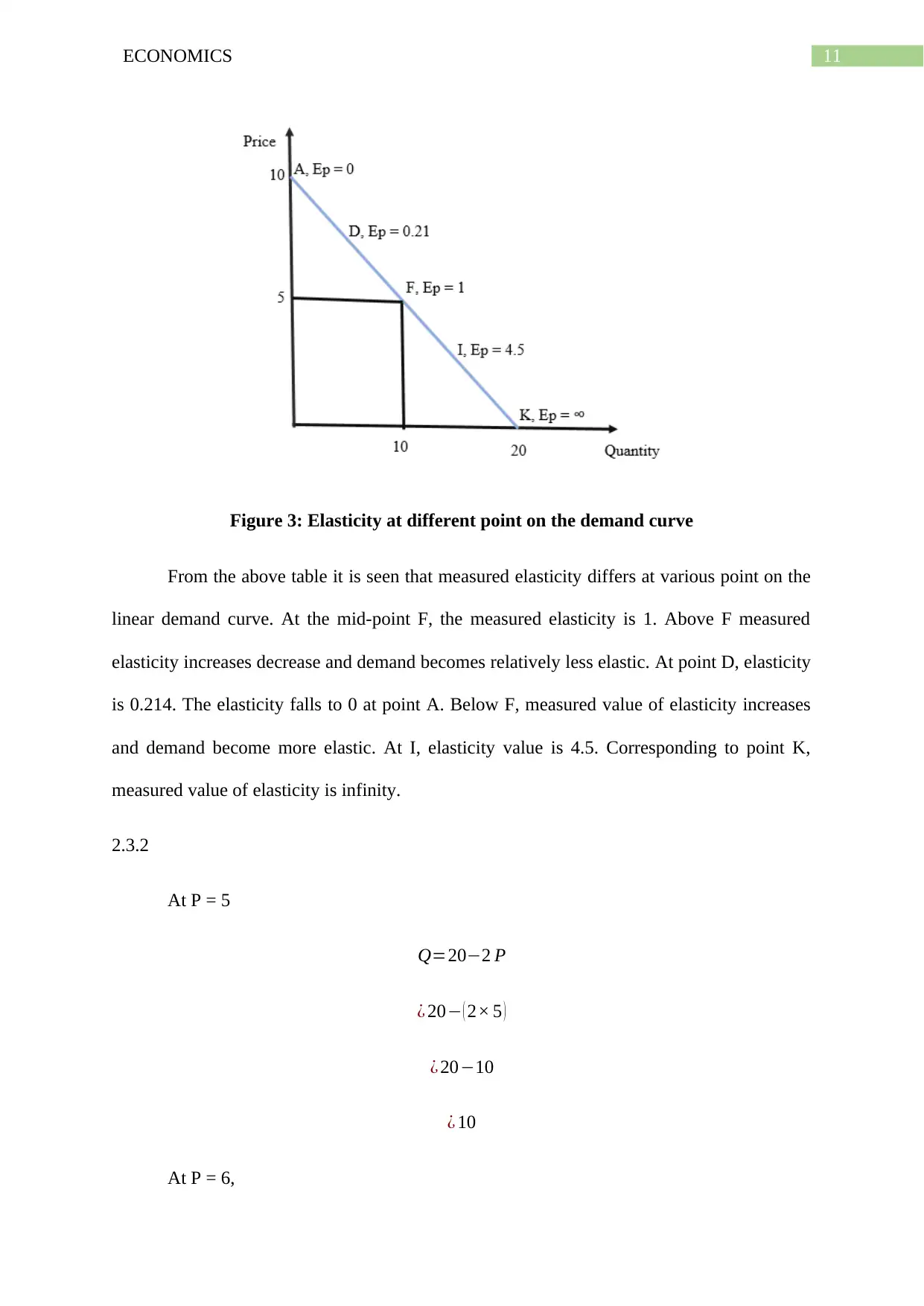
11ECONOMICS
Figure 3: Elasticity at different point on the demand curve
From the above table it is seen that measured elasticity differs at various point on the
linear demand curve. At the mid-point F, the measured elasticity is 1. Above F measured
elasticity increases decrease and demand becomes relatively less elastic. At point D, elasticity
is 0.214. The elasticity falls to 0 at point A. Below F, measured value of elasticity increases
and demand become more elastic. At I, elasticity value is 4.5. Corresponding to point K,
measured value of elasticity is infinity.
2.3.2
At P = 5
Q=20−2 P
¿ 20− ( 2× 5 )
¿ 20−10
¿ 10
At P = 6,
Figure 3: Elasticity at different point on the demand curve
From the above table it is seen that measured elasticity differs at various point on the
linear demand curve. At the mid-point F, the measured elasticity is 1. Above F measured
elasticity increases decrease and demand becomes relatively less elastic. At point D, elasticity
is 0.214. The elasticity falls to 0 at point A. Below F, measured value of elasticity increases
and demand become more elastic. At I, elasticity value is 4.5. Corresponding to point K,
measured value of elasticity is infinity.
2.3.2
At P = 5
Q=20−2 P
¿ 20− ( 2× 5 )
¿ 20−10
¿ 10
At P = 6,
⊘ This is a preview!⊘
Do you want full access?
Subscribe today to unlock all pages.

Trusted by 1+ million students worldwide
1 out of 18
Related Documents
Your All-in-One AI-Powered Toolkit for Academic Success.
+13062052269
info@desklib.com
Available 24*7 on WhatsApp / Email
![[object Object]](/_next/static/media/star-bottom.7253800d.svg)
Unlock your academic potential
Copyright © 2020–2025 A2Z Services. All Rights Reserved. Developed and managed by ZUCOL.




